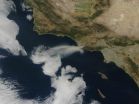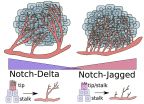FEATURED ARTICLE Morphometry of mass transport deposits as a predictive tool
L. Moscardelli and L. Wood, Bureau of Economic Geology, The University of Texas at Austin now at Statoil Research Development and Innovation, Austin, Texas. Published online ahead of print on 8 July 2015; http://dx.doi.org/10.1130/B31221.1.
Other GSA BULLETIN articles (see below) cover such topics as 1. A new model for the mechanisms and internal flow processes in operation during sand injection (open-access study);
2. The first comprehensive provenance investigation of the siliciclastic succession of Taimyr (Arctic Russia), from the late Carboniferous to the Jurassic; and
3. The geometry of the ~1.3 billion-year-old Voisey's Bay magma intrusion (Labrador) and its associated world-class (and currently mined) nickel-copper deposit.
Indicators of propagation direction and relative depth in clastic injectites: Implications for laminar versus turbulent flow processes
S.L. Cobain et al., School of Earth and Environment, University of Leeds, Leeds, UK. Published online ahead of print on 8 July 2015; http://dx.doi.org/10.1130/B31209.1. This article is OPEN ACCESS.
This new GSA Bulletin article by S.L. Cobain et al., published online ahead of print on 8 July, provides a new set of criteria for determining flow direction and depth of emplacement within clastic injectites. Clastic injectites are widely recognized in deep-water stratigraphic successions, although their sediment transport processes, propagation direction, and depth of injection are poorly constrained. Understanding how they form is important, because injectites are increasingly being recognized as significant components of sedimentary basin fills, yet are not predicted by standard sedimentary facies models. In this open-access study, S.L. Cobain and colleagues present detailed outcrop observations in the Karoo Basin of South Africa, integrated with the existing literature, to develop a new model that considers the mechanisms and internal flow processes in operation during sand injection that address the following fundamental issues: (1) determining injection propagation direction using margin structures; (2) estimating relative depth of injection from these structures; and (3) calculating the flow processes involved during injection.
Reconstruction of tectonic events on the northern Eurasia margin of the Arctic, from U-Pb detrital zircon provenance investigations of late Paleozoic to Mesozoic sandstones in southern Taimyr Peninsula
X. Zhang et al., Stockholm University, Stockholm, Sweden. Published online ahead of print on 30 June 2015; https://dx.doi.org/10.1130/B31241.1.
Taimyr is a remote region in Arctic Russia. Its geology is crucial for understanding continental collision and basin development in Eurasia and, perhaps more importantly, in the poorly known circum-Arctic region. This is the first comprehensive provenance investigation of the siliciclastic succession of Taimyr, from the late Carboniferous to the Jurassic, and it provides an important missing link for understanding Arctic tectonic evolution within a regional framework. The resulting data bear on the provenance of these late Paleozoic to Mesozoic sediments and the timing of Uralian uplift and exhumation as well as the influence of Siberian Trap magmatism in Taimyr.
On the emplacement of the Voisey's Bay Intrusion (Labrador, Canada)
B.M. Saumur and A.R. Cruden, Monash University, Clayton, Victoria, Australia. Published online ahead of print on 30 June 2015; http://dx.doi.org/10.1130/B31240.1.
This study by B.M. Saumur and A.R. Cruden focuses on the geometry of the ~1.3 billion-year-old Voisey's Bay magma intrusion (Labrador) and its associated world-class (and currently mined) nickel-copper deposit, and how this intrusion was emplaced into the crust. New information on the intrusion was obtained from fieldwork, drill core and an important database of subsurface information on the intrusion and surrounding rocks. The intrusion consists of an upper chamber (Eastern Deeps) and a lower chamber (Western Deeps); these are connected by a network of tabular feeder dykes. The Eastern Deeps can be divided into six units that show distinct geometries and styles of magma emplacement, and are temporally distinct. The Eastern Deeps was emplaced incrementally, from the top-down, by floor subsidence. Feeder dykes are only associated with the lowermost and latest units of the Eastern Deeps, and delivered most of the Ni-Cu sulphide-rich magmas that form the deposit today. This work provides significant insight on how intrusions are emplaced and Ni-Cu deposits form.
Paleomagnetic and petrologic study of the age, origin, and significance of early and late Paleozoic events in the Long Mountain Granite, Wichita Mountains, Oklahoma
E.M. Hamilton et al., University of Oklahoma, Norman, Oklahoma, USA. Published online ahead of print on 8 July 2015; http://dx.doi.org/10.1130/B31277.1.
Long Mountain, which exposes part of a granitoid intrusion in the western Wichita Mountains, Oklahoma, provides an ideal place to investigate the timing and origin of reddening in granites. One objective of the study was to test if the reddening records increased weathering related paleoclimatic conditions at the end of the Permian. The reddened granites contain a chemical remanent magnetization that is interpreted to have been acquired during alteration by low-temperature weathering fluids near the surface in the late Paleozoic. The results are not consistent with alteration caused by widespread paleoclimatic conditions in the Late Permian, and are interpreted as related to local tectonic and/or weathering events. The relatively unaltered green Long Mountain Granite is interpreted to contain a primary Cambrian thermal remanent magnetization or an early magnetization related to deuteric/hydrothermal alteration.
Sector collapse events at volcanoes in the North Tanzanian Divergence Zone and their implications for regional tectonics
A. Delcamp et al., Vrije Universiteit Brussel, Brussel, Belgium. Published online ahead of print on 30 June 2015; http://dx.doi.org/10.1130/B31119.1.
Volcanoes undergo gravitational and tectonic deformation which create instability. Such instability eventually leads to a collapse that can affect a small portion or a whole flank of the volcano. The resulting debris avalanche can travel long distance depending on the collapsed volume. North Tanzania hosts several stratovolcanoes, including Meru and Kilimanjaro. In this study, A. Delcamp and colleagues report 15 debris avalanches that affected 6 volcanoes, most of which were not previously reported. The orientations of the collapses are strongly linked to the orientation of the rift tectonic structures which highlight the role of the regional tectonic on volcano instabilities. Such hazard poses a threat to local population, especially that they are often associated with secondary debris flows.
Evolution of the Early to Middle Ordovician Popelogan Arc in New Brunswick, Canada, and adjacent Maine, USA: Record of arc-trench migration and multiple phases of rifting
C.R. van Staal et al., Pacific Division, Geological Survey of Canada, Vancouver, British Columbia, Canada. Published online ahead of print on 30 June 2015; http://dx.doi.org/10.1130/B31253.1.
Synthesizing new geochronological data with many years of geological investigations in the Appalachians of New England and Atlantic Canada, this paper by Cees van Staal and colleagues presents a detailed tectonic analysis of the evolution of a volcanic arc that developed on the Ganderian microcontinent during subduction-related closure of the Iapetus ocean in Ordovician time. Fossil and stratigraphic data are used to establish regional correlations in support of geochemical and geochronological evidence of northwesterly retreat of the subduction zone and consequent migration of the arc over time. Systematic variations in volcanic rock chemistry indicate that the arc developed in two phases, each punctuated by episodes of crustal extension that culminated in opening of a backarc oceanic basin. Few retreating arc-trench systems have been documented in ancient mountain belts such as the Appalachians; this study demonstrates how retreat was accommodated and reveals a tectonic scenario that is analogous with modern arc systems in the southwestern Pacific Ocean.
Paleointensity during periods of rapid reversal: A case study from the Middle Jurassic Shamrock Batholith, western Nevada
C.J. Sprain et al., Department of Earth Sciences, University of Minnesota, 310 Pillsbury Drive SE, Minneapolis, Minnesota 55455, USA. Published online ahead of print on 8 July 2015; http://dx.doi.org/10.1130/B31283.1.
The paleointensity of ~166-million-year-old plutonic rocks emplaced during of period of rapid geomagnetic reversal (~10 reversals/million years) is determined in this study by C.J. Sprain and colleagues, providing a high-quality estimate of Earth's magnetic field strength for a time where this type of data is notoriously lacking. This data helps test two important hypotheses that affect the understanding of how Earth's field strength has varied in the past: (1) the Mesozoic dipole low (MDL) hypothesis which suggests that a period of below average field strength occurred during the Mesozoic, and (2) the inverse hypothesis, which suggests that an inverse relationship between geomagnetic reversal frequency and magnetic field strength exists. The results presented by Sprain and colleagues support both hypotheses and show that the strength of the magnetic field ~166 million years ago was roughly 60% lower than today's field. This result helps to constrain the behavior of the geodynamo through Earth's history, ultimately informing models of geodynamo generation.
Clustering of offsets on the Haiyuan Fault and their relationship to paleoearthquakes
Z. Ren et al., State Key Laboratory of Earthquake Dynamics, Institute of Geology China Earthquake Administration, Beijing, China. Published online ahead of print on 30 June 2015; http://dx.doi.org/10.1130/B31155.1.
The relationship between offset distribution and rupture pattern of active faults is the key issue in active tectonics studies. Zhikun Ren and colleagues use airborne LiDAR data to evaluate the clustering of offsets and their relationship to paleoearthquakes along the Haiyuan Fault, where a Ms 8.5 earthquake occurred in 1920. This is the first application of LiDAR data in active tectonics researches in China. The offset observations along both the western and middle segments fall into groups. Comparing their results with the paleoseismological data, Ren and colleagues find that the events on the western segment did not correspond one-to-one with the events on the middle segment. An analysis of offset clusters should also consider the segmentation of the fault and available paleoseismic data. These new findings will shed new light on researches associated with active tectonics, geomorphology as well as earthquake sciences, which is of interest to a broad audience.
Thick sulfate evaporite accumulations marking a mid-Neoproterozoic oxygenation event (Ten Stone Formation, Northwest Territories, Canada)
E.C. Turner and A. Bekker, Laurentian University, Sudbury, Ontario Canada (Turner); University of California, Riverside, California, USA (Bekker). Published online ahead of print on 8 July 2015; http://dx.doi.org/10.1130/B31268.1.
The order in which minerals precipitate from evaporating seawater is a reflection of the prevailing concentration of oxygen in the atmosphere and ocean, and has changed through time in concert with Earth's evolving atmosphere-ocean system. Today, gypsum (calcium sulfate) precipitates before halite (sodium chloride) because the high level of oxygen in the modern atmosphere rapidly weathers sulfide minerals exposed on continents. The resulting dissolved sulfate is transported by rivers to the ocean, where it can become locally concentrated through evaporation and precipitate as gypsum, well before halite reaches saturation. This paper by E.C. Turner and A. Bekker documents a change in the order of mineral precipitation from seawater over 800 million years ago, from halite-first (low atmospheric oxygen) to sulfate-first (comparatively high atmospheric oxygen). A Neoproterozoic oxygenation event may have taken place considerably earlier than previously considered possible, well before the Ediacaran-Cambrian boundary (541 million years ago).
INFORMATION:
GSA BULLETIN articles published ahead of print are online at http://gsabulletin.gsapubs.org/content/early/recent; abstracts are open-access at http://gsabulletin.gsapubs.org/. Representatives of the media may obtain complimentary copies of articles by contacting Kea Giles.
Sign up for pre-issue publication e-alerts at http://www.gsapubs.org/cgi/alerts for first access to new journal content as it is posted. Subscribe to RSS feeds at http://gsabulletin.gsapubs.org/rss/.
Please discuss articles of interest with the authors before publishing stories on their work, and please make reference to GSA Bulletin in your articles or blog posts. Contact Kea Giles for additional information or assistance.
Non-media requests for articles may be directed to GSA Sales and Service, gsaservice@geosociety.org.


